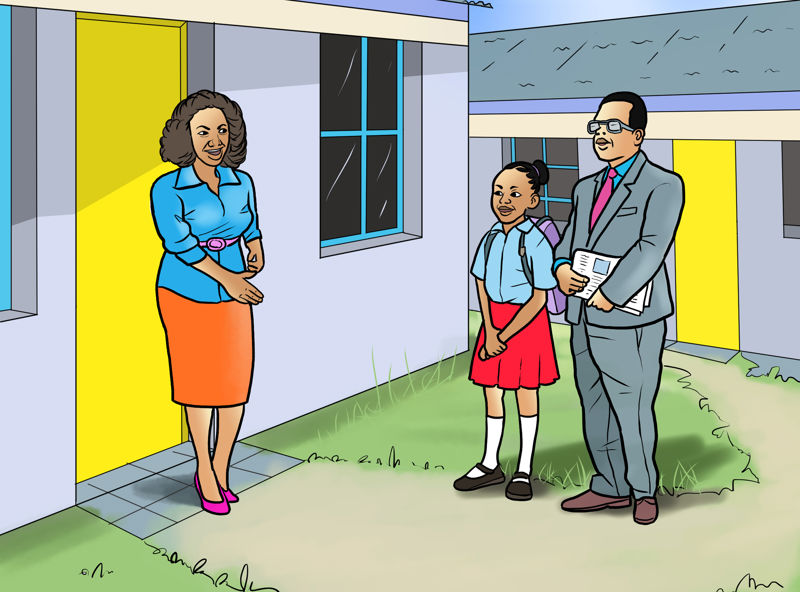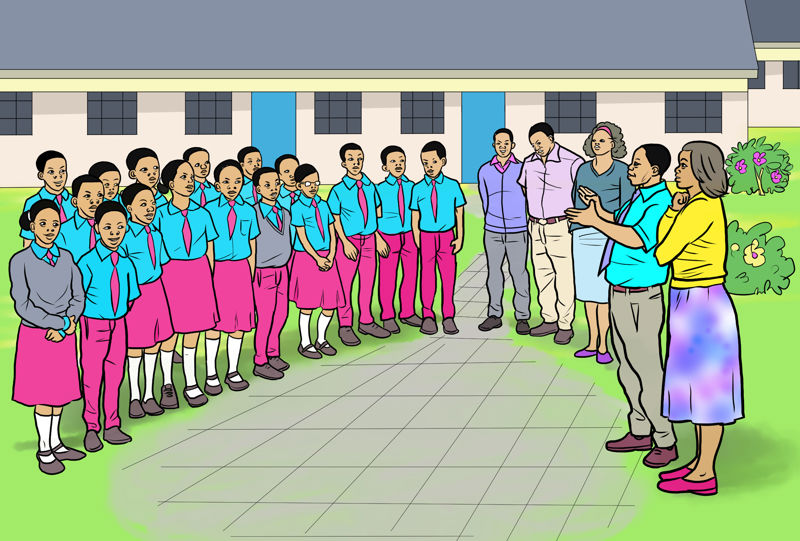Conversational skills: Polite language

Activity 1: Role-play and discuss
In groups, study the picture and say what you think is happening. Role-play the conversation given.
Maria: | Good morning, Madam. My name is Maria Arani. I am a new student joining Grade 7A. |
Mrs Maina: | Good morning, Maria. I am Mrs Maina, the Grade 7A class teacher. |
Maria: | Thank you, Mrs Maina. Please meet my father, Dr Joseph Arani. |
Mrs Maina: | It is a pleasure to meet you, Dr Arani. Welcome. |
Dr Arani: | Thank you, Mrs Maina. Pleased to meet you too. |
- Who introduces who in the conversation? Discuss as a class.
- Identify and say the polite expressions used in the conversation.
- Mention any other polite expressions one can use during introductions. Make a list of these expressions.
- Why do you think one has to be polite during an introduction?
Activity 2: Study and compare
Maria meets her classmate. Study how she introduces herself.
Maria: | Hello, my name is Maria. |
Peter: | Hello Maria, I am Peter |
Maria: | Nice to meet you, Peter. |
Peter: | It is my pleasure too. |
Maria: | I am excited to join Grade 7 and a new school. |
Peter: | Oh yes! It is really exciting to join Junior Secondary. |
- In pairs, role-play the introduction between Maria and Peter.
- Compare this introduction with that in Activity 1. Where does Maria sound more relaxed? Why do you think that is so?
- Match a and b below with the introductions in Activity 1 and 2.
- Formal introduction
- It is done in a formal set-up.
- It is used to introduce chief guests, parents or teachers.
- It includes the title of the person and other key details.
- It uses the full name of a person.
Formal introduction was used in.
- Informal introduction
- It is done in an informal set-up.
- It is used to introduce peers.
- It is casual and relaxed.
- Both parties may use only their first name.
Informal introduction was used in.
- Formal introduction
Activity 3: Play a game
- In groups, play a game of catch the ball to introduce yourself and others. Use polite expressions. Your teacher will guide you.
- List the polite expressions you have used in the game. Fill them in a table as shown below.
- Share the table with the class. Discuss why it is important to model respectful behaviour during an introduction.
Polite expression | When to use it | Example in a sentence |
please | To make a request | Please tell me your name. |
Did you know?
You can introduce yourself (self-introduction) or introduce someone else to others, such as a guest (introducing others).
Introductions
Activity 4: Listen and dramatise
- Study the picture given. Talk about it with your deskmate.
- Listen keenly as your teacher reads a short story about the picture.
- In groups, brainstorm and list the details the head teacher needed to know so as to introduce the officer to the teachers and the learners.
- Dramatise the head teacher introducing herself to the officer.
- Dramatise the head teacher introducing the officer to the teachers and the learners.
- Present your work to the class for peer assessment.

Find out
Work in groups. With the help of your teacher, parent or guardian, find and watch video clips on introductions. Classify them as formal or informal introductions. Discuss if the speakers are polite or not and then say why. Share your work with the class.
Further activity
- With the help of a parent or guardian, make a video of yourself introducing a cousin to your friends or main speakers during a class debate. Use polite expressions and model respectful behaviour.
- Share the recording with peers for assessment and correcting.
Task | I can do this. | I need more practice. | I need help. |
I can use polite expressions to introduce myself and others. |
